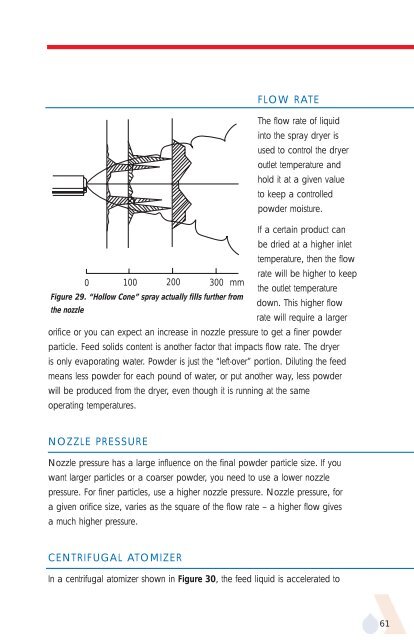APV Dryer Handbook - Umbc
APV Dryer Handbook - Umbc
APV Dryer Handbook - Umbc
Create successful ePaper yourself
Turn your PDF publications into a flip-book with our unique Google optimized e-Paper software.
FLOW RATE<br />
The flow rate of liquid<br />
into the spray dryer is<br />
used to control the dryer<br />
outlet temperature and<br />
hold it at a given value<br />
to keep a controlled<br />
powder moisture.<br />
If a certain product can<br />
be dried at a higher inlet<br />
temperature, then the flow<br />
rate will be higher to keep<br />
0 100 200 300 mm<br />
the outlet temperature<br />
Figure 29. “Hollow Cone” spray actually fills further from<br />
down. This higher flow<br />
the nozzle<br />
rate will require a larger<br />
orifice or you can expect an increase in nozzle pressure to get a finer powder<br />
particle. Feed solids content is another factor that impacts flow rate. The dryer<br />
is only evaporating water. Powder is just the “left-over” portion. Diluting the feed<br />
means less powder for each pound of water, or put another way, less powder<br />
will be produced from the dryer, even though it is running at the same<br />
operating temperatures.<br />
NOZZLE PRESSURE<br />
Nozzle pressure has a large influence on the final powder particle size. If you<br />
want larger particles or a coarser powder, you need to use a lower nozzle<br />
pressure. For finer particles, use a higher nozzle pressure. Nozzle pressure, for<br />
a given orifice size, varies as the square of the flow rate – a higher flow gives<br />
a much higher pressure.<br />
CENTRIFUGAL ATOMIZER<br />
In a centrifugal atomizer shown in Figure 30, the feed liquid is accelerated to<br />
61











